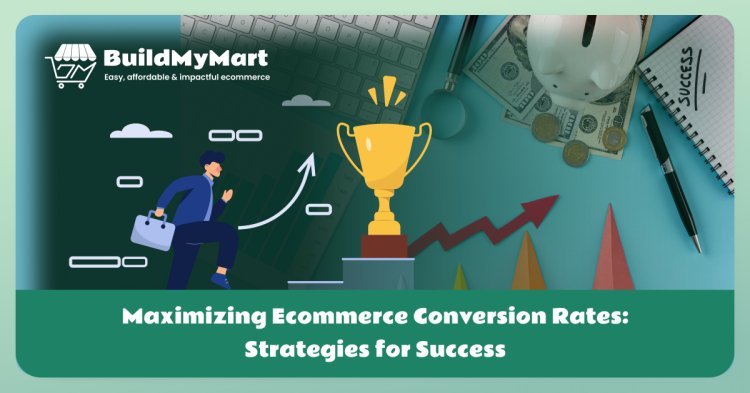Maximizing Ecommerce Conversion Rates: Strategies for Success

Introduction:
In the highly competitive landscape of ecommerce, converting website visitors into paying customers is crucial for driving sales and achieving business growth. Ecommerce conversion rates, which measure the percentage of visitors who complete a desired action, such as making a purchase or signing up for a newsletter, are key metrics that businesses need to optimize for success. In this comprehensive guide, we will explore the factors that influence ecommerce conversion rates, strategies for improving them, and best practices for maximizing sales and revenue.
1. Understanding Ecommerce Conversion Rates:
a. Definition and Importance:
Definition
Maximizing ecommerce conversion rates refers to the process of optimizing various elements of an ecommerce website or platform to increase the percentage of website visitors who complete desired actions, such as making a purchase, signing up for a newsletter, or filling out a contact form. This involves implementing strategic tactics and techniques aimed at improving user experience, enhancing trust and credibility, and ultimately driving more conversions and revenue for the business.
Importance:
Maximizing ecommerce conversion rates is essential for the success and profitability of online businesses.
b. Types of Conversions:
There are different types of conversions, including Purchase Conversion, Social Media Engagement, lead generation conversions, Cart Abandonment Recovery Conversion, micro-conversions such as email sign-ups or social media engagement and Upsell and Cross-Sell Conversion.
2. Factors Influencing Ecommerce Conversion Rates:
a. Website Design and User Experience:
A well-designed website with intuitive navigation, clear calls-to-action, and user-friendly interfaces can significantly impact conversion rates. A cluttered or confusing website layout can deter visitors from acting and lead to higher bounce rates.
b. Product Presentation and Descriptions:
High-quality product images, detailed descriptions, and persuasive copy can help visitors make informed purchasing decisions and increase trust in the product and brand. Including customer reviews and ratings can also provide social proof and positively influence conversion rates.
c. Pricing and Value Proposition:
Analyse how pricing strategies, discounts, and value propositions can impact conversion rates, highlighting the importance of perceived value and competitive pricing.
d. Trust and Credibility:
Building trust with visitors is essential for encouraging conversions. Displaying trust signals such as security badges, customer testimonials, and industry certifications can reassure visitors about the safety and reliability of the website, leading to higher conversion rates.
e. Checkout Process Optimization:
Examine common barriers to conversion, such as lengthy checkout processes, hidden fees, and lack of guest checkout options, and discuss strategies for streamlining the checkout process to reduce friction and improve conversions.
3. Strategies for Improving Ecommerce Conversion Rates:
a. A/B Testing and Experimentation:
Advocate for a data-driven approach to conversion rate optimization, emphasizing the importance of conducting A/B tests and experiments to identify high-impact changes and optimizations.
Personalization and Targeting: Discuss the benefits of personalized shopping experiences, targeted messaging, and dynamic content recommendations in increasing engagement and driving conversions.
b. Retargeting and Abandoned Cart Recovery:
Highlight the effectiveness of retargeting campaigns and abandoned cart recovery emails in re-engaging lost visitors and recovering potential sales.
c. Customer Support and Assistance:
Emphasize the role of proactive customer support, live chat assistance, and product recommendations in addressing customer concerns, answering questions, and guiding visitors through the purchasing process.
d. Post-Purchase Engagement:
Explore strategies for nurturing customer relationships post-purchase, such as follow-up emails, loyalty programs, and personalized recommendations, to encourage repeat purchases and increase customer lifetime value.
4. Measuring and Analysing Conversion Rates:
a. Key Metrics and KPIs:
Identify important metrics and key performance indicators (KPIs) for tracking ecommerce conversion rates, such as conversion rate, average order value, cart abandonment rate, and customer lifetime value.
b. Analytics Tools and Platforms:
Discuss popular analytics tools and platforms, such as Google Analytics, Shopify Analytics, and Adobe Analytics, for measuring and analysing conversion rates and performance metrics.
5. Case Studies and Success Stories:
Showcase case studies and success stories of ecommerce businesses that have successfully optimized their conversion rates, detailing their strategies, challenges, and outcomes.
Analyse different industry verticals, business models, and scales of operation to provide diverse insights and practical takeaways for readers.
Conclusion:
By understanding the factors that influence ecommerce conversion rates and implementing effective strategies for optimization, businesses can maximize their sales and revenue potential, improve customer engagement and satisfaction, and achieve long-term success in the competitive world of ecommerce. Conversion rate optimization is an ongoing process that requires experimentation, analysis, and continuous improvement to drive meaningful results and unlock the full potential of online sales and growth.
What's Your Reaction?










![Blog Submission Sites 2024 [High DA]](https://blognow.co.in/uploads/images/202306/image_100x75_6494a03eaff5e.jpg)
![Article Submission Sites 2023 [High DA & PA]](https://blognow.co.in/uploads/images/202307/image_100x75_64c4181f17036.jpg)
![Classified Submission Sites 2023 [High DA & PR]](https://blognow.co.in/uploads/images/202306/image_100x75_649dcd5260808.jpg)




![Article Submission Sites 2023 [High DA & PA]](https://blognow.co.in/uploads/images/202307/image_750x415_64c4181f08ed5.jpg)
![Classified Submission Sites 2023 [High DA & PR]](https://blognow.co.in/uploads/images/202306/image_750x415_649dcd5247eeb.jpg)
![Blog Submission Sites 2024 [High DA]](https://blognow.co.in/uploads/images/202306/image_750x415_6494a03e96bfa.jpg)
